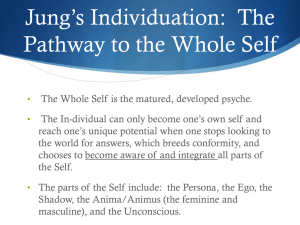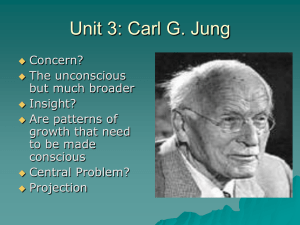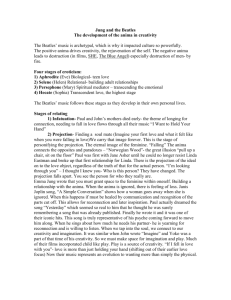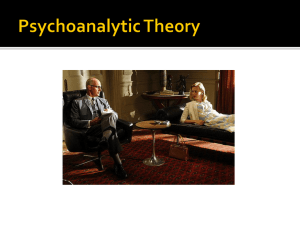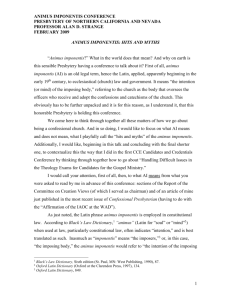CG Jung`s Archetypes of the Unconscious
advertisement
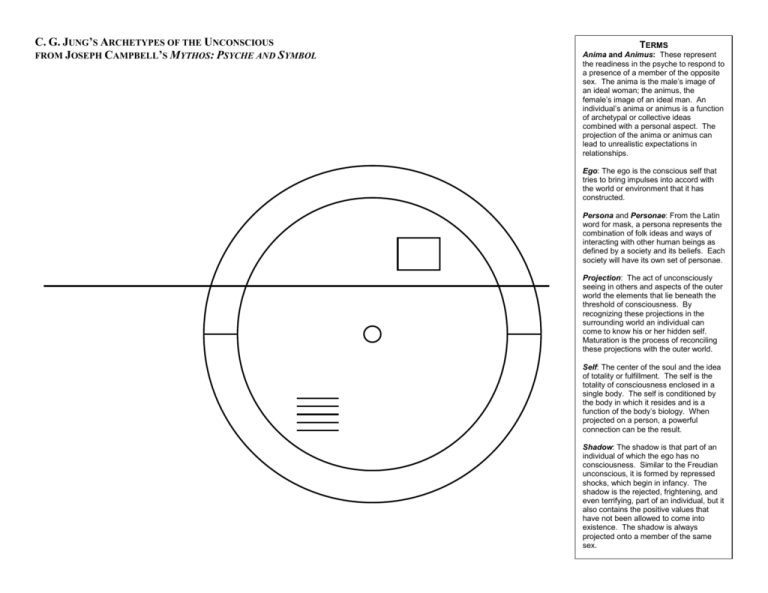
C. G. JUNG’S ARCHETYPES OF THE UNCONSCIOUS FROM JOSEPH CAMPBELL’S MYTHOS: PSYCHE AND SYMBOL TERMS Anima and Animus: These represent the readiness in the psyche to respond to a presence of a member of the opposite sex. The anima is the male’s image of an ideal woman; the animus, the female’s image of an ideal man. An individual’s anima or animus is a function of archetypal or collective ideas combined with a personal aspect. The projection of the anima or animus can lead to unrealistic expectations in relationships. Ego: The ego is the conscious self that tries to bring impulses into accord with the world or environment that it has constructed. Persona and Personae: From the Latin word for mask, a persona represents the combination of folk ideas and ways of interacting with other human beings as defined by a society and its beliefs. Each society will have its own set of personae. Projection: The act of unconsciously seeing in others and aspects of the outer world the elements that lie beneath the threshold of consciousness. By recognizing these projections in the surrounding world an individual can come to know his or her hidden self. Maturation is the process of reconciling these projections with the outer world. Self: The center of the soul and the idea of totality or fulfillment. The self is the totality of consciousness enclosed in a single body. The self is conditioned by the body in which it resides and is a function of the body’s biology. When projected on a person, a powerful connection can be the result. Shadow: The shadow is that part of an individual of which the ego has no consciousness. Similar to the Freudian unconscious, it is formed by repressed shocks, which begin in infancy. The shadow is the rejected, frightening, and even terrifying, part of an individual, but it also contains the positive values that have not been allowed to come into existence. The shadow is always projected onto a member of the same sex. THE PROCESS OF INDIVIDUATION INDIVIDUATION Individuation is the gradual development of a wider and more mature personality. The process of individuation is the lifelong psychic growth of an individual, which happens involuntarily and naturally. The process follows a pattern that Jung believed would emerge through dreams. The self serves as the organizing center of the regulatory effect of the process. THE FIRST APPROACH OF THE UNCONSCIOUS Beginning around the age of two and accelerating around school age, a child begins to distinguish between the inner world and outer world. During this time the ego is created, often followed by a number of painful shocks as the individual begins to recognize imperfections in the outer world and also in the inner world. The child often feels an urgent need to deal with both inner impulses and the demands of the outer world, though neither is well understood. For some this period is marked by sadness and loneliness because the individual feels different and unique. In others the deeper meaning of life is less of a concern as their daily experiences are satisfying and meaningful. Despite the initial response to the external world, individuals sooner or later will have to deal with a shock to the personality. This shock will hamper the ego and the response is typically to shift the blame to something or someone external. Instead of a shock some individuals may suffer from a deep internal boredom despite the outward appearance of normalcy. Outward blame leads nowhere, and the only way to solve the problem is to turn toward the darkness of the unconscious to identify the problem. Often this requires confronting what is wrong with one’s self and one’s conscious attitudes. When this process is undertaken consciously and willfully, it is the process of individuation. THE REALIZATION OF THE SHADOW The first type of criticism from the unconscious often comes in the form of the shadow, revealing the qualities and impulses that are denied in one’s self by the conscious ego. Whatever form it takes, the function of the shadow is to represent the opposite side of the ego. For example, on rare occasions, one who lives out the worse side of his nature can have a shadow that appears as a positive figure. If one lives out her natural emotions and feelings, the shadow may appear as a cold and negative intellectual. The impulses expressed by the shadow may be negative, in which case they should be recognized and repressed, but they may also contain valuable forces, which should be assimilated into experience. Determining this difference can be difficult, and the individual will have to proceed carefully to determine how the ego should respond to the shadow. THE ANIMA: THE WOMAN WITHIN Beyond the shadow another inner figure emerges—the anima in males, and the animus in females. These figures arise behind the shadow, bringing up new and different problems. As a rule the individual’s anima figure is shaped by his mother. The anima can appear as a negative figure. She can be expressed in irritable, depressed moods, uncertainty, insecurity, and as repeating the theme, “I am nothing,” which results in a sort of dullness, and a fear of disease, of impotence, or of accidents. This figure can even become a femme fatale, luring a man to suicide. Another negative anima might appear in waspish, poisonous, effeminate remarks, which the male uses to devalue everything. The male may even have a positive view of his mother, and sill have negative anima aspects, which turn him into a sentimentalist or an overly sensitive person. He may also frequently find himself in neurotic pseudo-intellectual dialogues that keep him from being directly involved in life and making decisions. The projection of the anima onto a woman can lead a man into a poorly suited relationship, or can work to undermine a relationship by being projected onto another woman outside the relationship. Anima figures have many positive aspects as well. They can help a man find the right partner, and can help a man’s logical mind discern facts hidden in his unconscious. The anima often works as a guide or mediator between the ego and the self. Anima figures often appear in one of four stages of development: the first stage represents purely instinctual and biological relations; the second is at a romantic and aesthetic level, though still with sexual elements; the third stage is a figure who raises love to the heights of spiritual devotion; and the fourth stage, represents a wisdom that transcends even the most holy and pure. THE ANIMUS: THE MAN WITHIN Similar to the anima for males, the animus can reveal itself negatively in women, commonly in the form of a hidden “sacred” conviction, preached with a loud, insistent voice or imposed on others by means of brutal emotional scenes. A common theme of the animus is “The only thing in the world that I want is love—and he doesn’t love me”; or “In this situation there are only two possibilities—and both are equally bad.” Though the animus opinion, which never believes in exceptions, is usually right in a general way, it seldom fits the individual situation. The animus is largely shaped by the individual’s father, who gives the daughter unarguable, incontestably “true” convictions that never include the personal reality of the woman as she actually is. There is an animus counterpart to the femme fatale who lures women away from human relationships, especially those with men. The negative animus can also act like a robber or murderer influencing a woman to lead her husband or children into illness, accidents, or death. There are also positive attributes: the animus too can act as a mediator between one’s ego and the self, often through his creative activity. The animus also appears in four stages: the first represents mere physical power; at the next stage initiative and capacity for planned action is exhibited by the animus; at the third, the animus becomes the “word”; and in the fourth stage, the animus is the incarnation of meaning. At the highest level the animus becomes a mediator of the religious experience whereby life acquires new meaning. THE SELF: SYMBOLS OF TOTALITY After confronting and integrating aspects of the shadow, and dealing sufficiently with the anima or animus so that an individual is no longer associated with either, a new dominant character will emerge. This character will represent the self. In females it typically appears as a superior female figure—a priestess, sorceress, earth mother, or goddess of nature or love. For a man it is typically a masculine initiator and guardian, a wise old man, a spirit of nature. These are typical but not definite forms: the self can also appear as a youthful character to represent a new vitality, or as an animal or stone to represent different ideas associated with those entities. If one is devoted to the instructions of the unconscious, life can suddenly turn into a rich, unending inner adventure, full of creative possibilities. The preceding notes are based on M. L. von Franz’s essay “The Process of Individuation” which appears in Man and His Symbols, edited by Carl Jung. The book was the last major undertaking of Jung’s life, in which he elicited the help of his students and colleagues to bring his life’s work to a general audience. Created by David Herring, University High School, Tucson, Arizona, November 2007.
